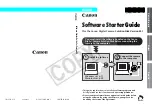
51
7: Modulation
7:1 Introduction to modulation in DCAM: Synth Squad
There are two ways of modulating parameters within Amber, Cypher and Strobe:
• Direct modulation routings
Some modulation sources are routed directly to certain commonly-used parameters for convenience. Some examples
include LFO, Mod Envelope and keytracking depth controls for the Osc Pitch, Pulse Width and Filter cutoff in Strobe.
• TransMod system
The TransMod system is used to map a single modulation source to multiple parameter destinations. It also allows you to
scale a source with another. There are a variety of monophonic and polyphonic mod sources available in the TransMod
system – many more than those available as direct routings.
MIDI Learn and automation
There two further ways of affecting parameters – direct MIDI Learn and parameter automation – which are discussed in
section 6:8.
These are not to be considered as synth modulation, but rather as a way of automating parameters from the host or from
a hardware controller.
The TransMod system explained
Essentially, TransMod is similar to the well-known ‘mod-matrix’ found in many synthesizers. However, instead of simply
connecting a modulation source to a single synthesis parameter and setting the depth or amount of modulation, TransMod
allows you to route a single modulation source to multiple synth parameters, each with its own definable depth.
The following diagram illustrates how a single modulation source, such as an LFO, is routed to destination parameters in a
traditional mod-matrix and in DCAM: Synth Squad’s TransMod system:
Traditional modulation matrix
DCAM: Synth Squad TransMod system
Содержание DCAM SYNTH SQUAD
Страница 1: ......
Страница 2: ......
Страница 26: ...26 Shaper Filter Amp sections...
Страница 109: ......
Страница 110: ......















































